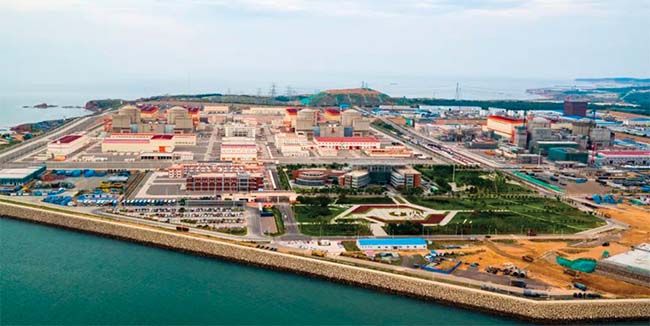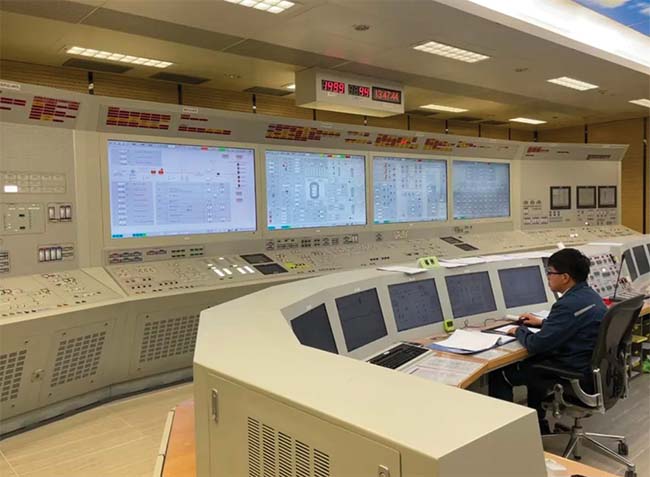New Units at Hongyanhe Further China’s Nuclear Ambition
Credit to Author: Darrell Proctor| Date: Tue, 01 Nov 2022 04:17:00 +0000

 |
An innovative design, emphasizing safety and economic efficiency, is key to the reactor technology at China’s newest—and now largest—nuclear power plant.
China’s nuclear power program has utilized several technologies over the years, drawing on the expertise of its own engineers and those of other nations while pursuing its own reactor development and technology export program.
The country’s 14th Five-Year Plan for economic development includes government plans for at least 70 GW of nuclear power generation capacity to be installed by 2025. Part of that plan already is in operation, as Units 5 and 6, or Phase II, of the Hongyanhe Nuclear Power Station came online over the past year. Hongyanhe’s six units provide a total of 6.71 GW of generation capacity, making it the largest nuclear power plant in China. The plant’s two newest units are notable for their use of the ACPR-1000 reactor, which emphasizes safe performance and economic efficiency.
“China is the most populous nation on Earth and also uses the most energy, a lot of it coming from burning coal,” said Dinara Ermakova, a nuclear engineer with the California-based Anthropocene Institute. Ermakova, noting the importance of nuclear power to China’s future economic growth, told POWER, “Energy demand is anticipated to rise in light of a rapidly expanding economy. China agreed to set bold objectives to reach ‘carbon neutrality’ before 2060 and a peak in CO2 emissions before 2030 in order to meet the objectives. The local market’s expansion of nuclear technologies will have an effect on the decarbonization of all manufacturing processes and carbon-intensive industries that require high temperatures, such as the production of steel and cement, all of which are difficult to accomplish with renewable energy sources.”
The Hongyanhe plant, located in Donggang Town, Wafangdian, in China’s Liaoning Province, is owned and operated by Liaoning Hongyanhe Nuclear Power Co. (LHNP), a joint venture between China General Nuclear (CGN) and State Power Investment Corp. Those groups each hold a 45% stake; the Dalian Municipal Construction Investment Co. holds the remaining 10%.
LHNP said the total investment in the six-unit power plant is about 75 billion RMB (Renminbi), or more than $12 billion. RMB is the official name of China’s currency; the principal unit of RMB is the yuan.
 |
1. A worker in the control room of Unit 6 of the Hongyanhe nuclear plant monitors operations. Unit 6 came online in June of this year. Courtesy: China General Nuclear |
CGN, in a June 23 news release announcing the start of operations for Unit 6 (Figure 1), wrote, “Hongyanhe Nuclear Power Station is the first nuclear power station in Northeast China and the largest power energy investment project in Northeast China. The project has built a total of six gigawatt-level nuclear power units. Hongyanhe Nuclear Power Unit 6, which was put into operation today, started construction in July 2015 and was connected to the grid for the first time on May 2 this year. Subsequently, a series of commissioning tests were carried out, and the 168-hour continuous full power operation assessment was successfully completed.”
The group wrote that as the “six units of Hongyanhe Nuclear Power Station Phase I and Phase II projects were fully put into operation,” the Hongyanhe facility “became China’s in-service largest nuclear power station in terms of installed capacity.” Hongyanhe’s importance to China’s future economic and energy growth, and the innovation of the reactor design in Units 5 and 6, led POWER to give the facility a Top Plant award.
ACPR-1000 Reactor
The ACPR-1000 reactor—ACPR stands for Advanced Chinese PWR (pressurized water reactor)—was designed by the China Guangdong Nuclear Power Corp., which changed its name to CGN in 2013. According to the International Atomic Energy Agency (IAEA), the reactor’s “design focuses on the safe performance of the reactor while improving the economic efficiency. This enhanced version of the 3-loop CPR-1000 has higher seismic standards, features a double containment and a reactor core catcher for SA [spectral acceleration] mitigation purposes. The reactor is designed with SAMS [seismic margin assessments] including such in-vessel retention and spray systems for containment heat removal.” The IAEA in a document detailing advanced large water-cooled reactor designs notes that the ACPR-1000 “meets major post-Fukushima safety requirements.”
“The Hongyanhe plant is now China’s largest nuclear generating facility, and one of the largest ever built worldwide,” said Leslie Dewan, co-founder of RadiantNano, a Massachusetts-based nuclear technology group. “The electricity it produces is vital for China’s move away from fossil fuels, especially in this region that was previously heavily reliant on coal power. With all six units operational, the plant will prevent the emission of approximately 40 million tons of CO2 per year. China’s aggressive expansion of its nuclear power sector shows that when a country is sufficiently motivated by factors such as air quality, climate change, and domestic energy security, this kind of rapid decarbonization becomes possible.”
Dewan noted that Hongyanhe “is important because it’s the first commercial nuclear heating project in Northeast China. Using nuclear power for district heating is a crucial component of decarbonizing the energy sector. The region previously generated district heat via coal boilers, which produced large amounts of CO2, sulfur oxides, nitrogen oxides, and fine particulates that led to significant air pollution. Nuclear heating is more reliable, safer, and doesn’t produce this pollution.”
Dewan, noting the importance of the reactor technology in Units 5 and 6 at Hongyanhe, told POWER, “The ACPR-1000 is part of the new generation of pressurized water reactors that were designed to meet post-Fukushima safety standards—they have a double containment, additional spray systems, a reactor core catcher, and improved seismic tolerance. Liaoning Province, where the power plant is located, has had significant earthquakes in the past, and improved seismic tolerance will also make these reactors much more attractive for export to earthquake-prone areas around the world. China is the sole owner of the intellectual property underlying the design, which could prove to be very valuable as China continues its push to export nuclear power technology.”
The first use of the ACPR-1000 was for Unit 5 at the Yangjiang Nuclear Power Plant in Guangdong Province in China; that reactor came online in 2018. CGN has said the reactor design includes the major technical characteristics and safety features of third-generation reactor units.
“PWR uses water as a coolant, which is pumped under high pressure to the reactor core and heated by the nuclear fission reaction,” Ermakova told POWER. “The PWR reactor design constitutes the majority of all reactors around the world. ACPR-1000 has full Chinese intellectual property rights that meet major post-Fukushima safety requirements, such as additional supplies of cooling water, along with supplies of modular emergency power. This is a significant project, which accounts for roughly 12% of the nation’s nuclear capacity and should provide both electricity and district heating. China is the sole owner of intellectual property, which enables the exportation of technology.”
Plant in Operation Since 2013
Units 1 and 2 at Hongyanhe have been in commercial operation since June 2013 and May 2014, respectively. Hongyanhe Units 1 and 2 were recognized as POWER Top Plants in 2014. Unit 3 came online in August 2015, and Unit 4 followed in September 2016. Construction of Unit 5 began in March 2015, and Unit 6 construction began four months later.
Officials associated with the nuclear plant said Unit 6, in addition to ensuring the power supply for the region in Northeast China, also will support heating of homes and businesses across an area of more than 242,000 square miles in the town of Hongyanhe this winter, the China Media Group reported in late September. The community endured blackouts last year due to a power shortfall.
 |
CGN in a news release said, “The annual generating capacity of the six units of Hongyanhe Nuclear Power Station can reach 48 billion kWh, accounting for about 20% of the total electricity consumption in Liaoning Province … compared with coal-fired power plants of the same scale, it is equivalent to reducing the consumption of standard coal by about 14.52 million tons, reducing emissions of carbon dioxide by about 39.93 million tons, equivalent to planting 108,000 hectares of forest.”
An official with the National Development and Reform Commission (NDRC), China’s top economic planning agency, in late September provided details about how China will continue to develop new types of power generation infrastructure. That includes nuclear power, with a goal of having 70 GW of nuclear power generation capacity installed by 2025, up from just more than 50 GW today. China’s installed generation capacity for renewable energy, which includes hydropower, solar, wind, and biomass, is about 1,100 GW, according to data from the country’s National Energy Administration. That’s more than three times that of the U.S., which ranks second in installed renewable energy generation capacity.
“Nuclear power is becoming economically viable due to the scale at which China plans to implement its nuclear projects,” said Ermakova. “China’s ability to standardize manufacturing across industries and its objective to provide a well-established system of design, quality assurance, safety, and nuclear power plant construction would allow it to avoid cost overruns and construction delays, which are factors that affect the overall economics of nuclear projects.”
Ermakova added: “With a reactor like the ACPR-1000 that comes complete with intellectual property rights, China would be able to start exporting technologies to countries in Asia and potentially to Western countries as well. Nuclear power is a key component of China’s plans to export energy technologies under the Belt and Road Initiative, and if China is able to provide flexible financing to developing nations while also perfecting the system to construct standardized nuclear power plants, these plans will soon become a reality and it will have a tremendous impact on the global climate change fight.”
—Darrell Proctor is a senior associate editor for POWER (@POWERmagazine).
The post New Units at Hongyanhe Further China’s Nuclear Ambition appeared first on POWER Magazine.